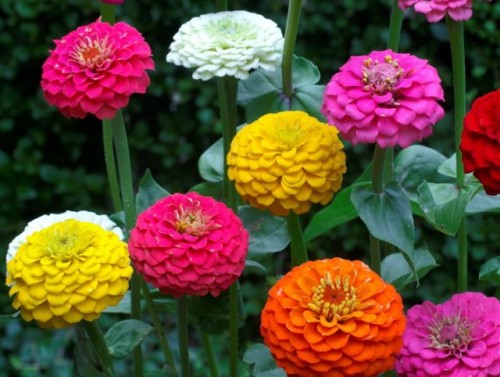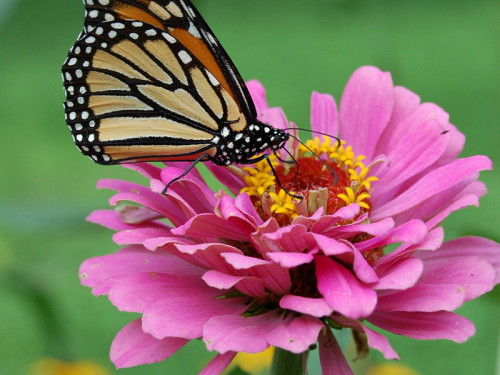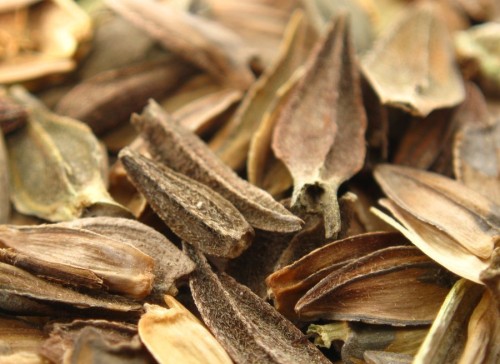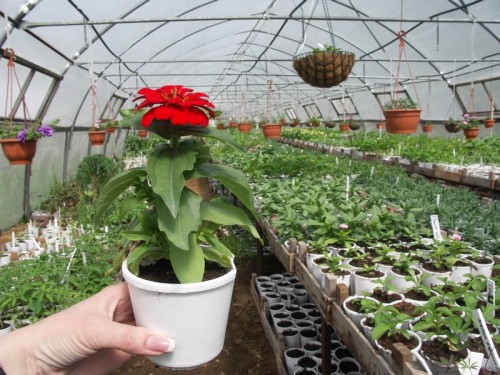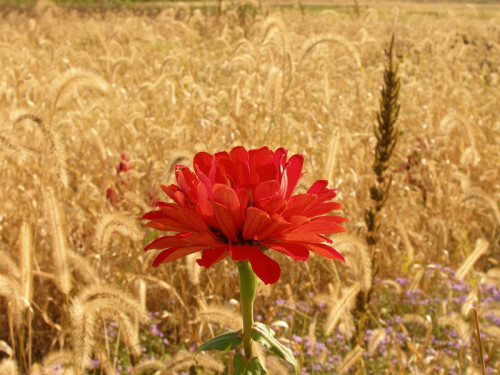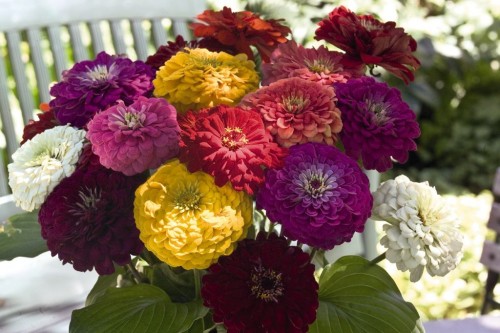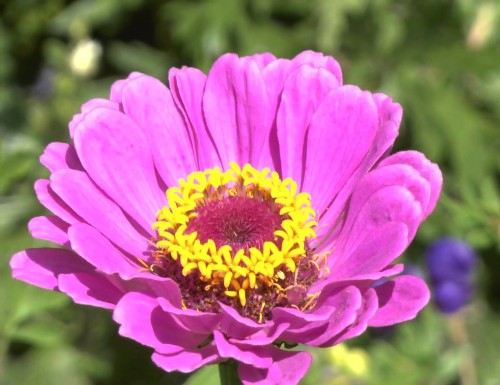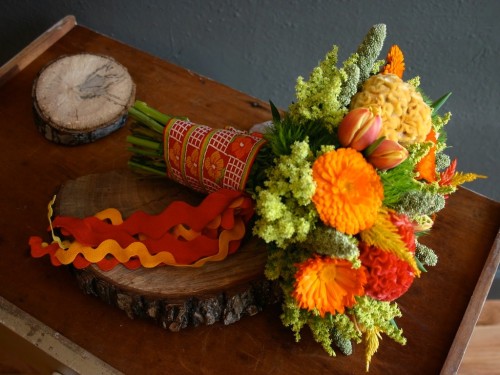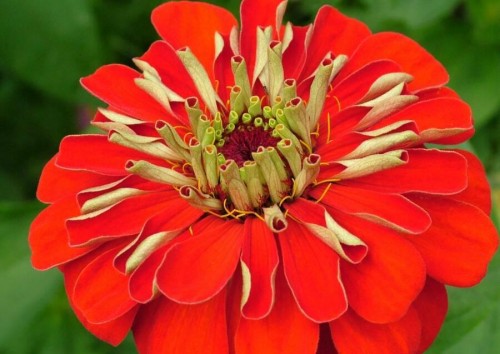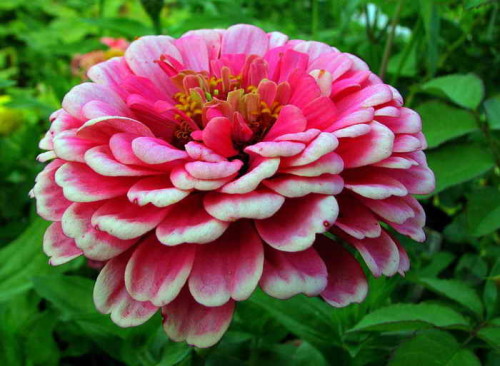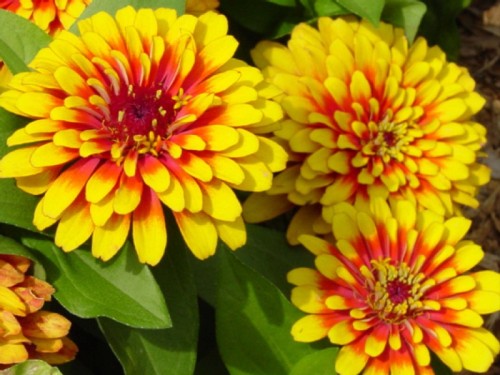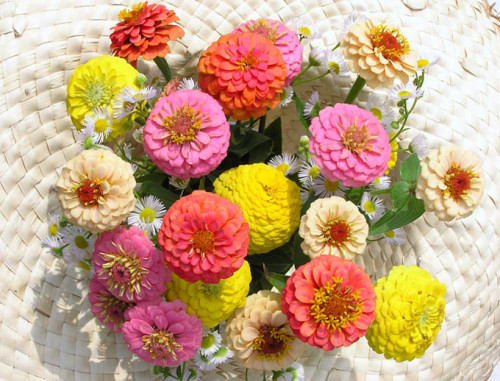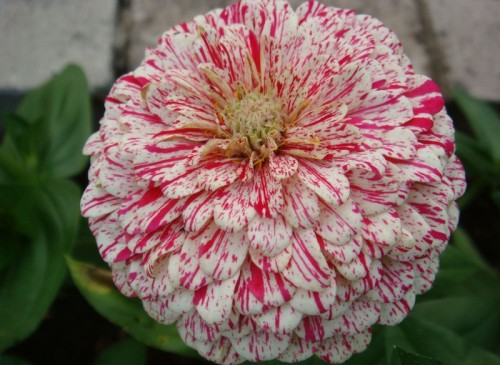
Zinnia Elegant: Features of growing in the garden plot Useful advice,Plot
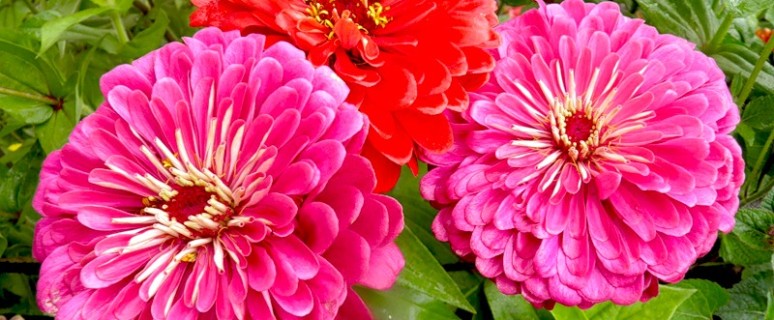
Zinnia is elegant loved by many gardeners for the extraordinary beauty, variety of varieties, as well as for unpretentiousness. Motion buds of this plant can be found on the flower beds and lawns, the zinnia is widely used in the creation of bright flower compositions, and in addition, it can be grown even in the apartment. The abundance of the shades of the flower does not know the limits. There are zinnia of gentle pink, bright red, saturated violet, orange, yellow and other tones. In our article, you will find a detailed description of Qinnia Elegant, learn information about its types and varieties, and also draw useful information about growing culture and care.
Content
Basic Flower
Native Zinnia is a hot mexico. In European countries, the plant has acquired popularity at the end of the 18th century. Zinnia is an annual culture having a thin straight stem, the length of which fluctuates in the range of 30-90 cm. The plant develops quite quickly, the stem is covered with a dark green shade with leaves. The foliage has a pointed oblong shape, the edges are smoothed. Stems, like the leaves, are covered with hard insertion. Motion buds reach in diameter from 3 to 14 cm, depending on the culture variety.
Flowering zinnia continues from the middle of the summer to late autumn, during this time the plant produces quite a large number of buds. Due to such abundant blossoms, zinnia is often used in the creation of slatas and other compositions with well-pronounced patterns. This culture gives major fruits in the form of seeds, the size of which varies within 8-12 mm. Seeds have an eyeling for 3 years.
The plant begins to bloom about 55-65 days after her seeds were planted into the ground. The life of separately taken buds is 34-35 days.
Types and varieties of zinnia
Depending on the height of the stems, shapes and size of inflorescences, the zinnia is customary to divide into several species, each of which is represented by a variety of varieties. The following varieties of culture are known to gardeners:
- chrysanthemics;
- georgic color;
- pomponny or Liliputa;
- scabiosolovoy;
- guyirdi colors;
- qinnia fantasy.
In our country, the most popular are zinnia Georgian and Pomponny, some gardeners prefer to breed the flowers of the group fantasy. You can find various seed mixtures in which many varieties of culture are presented. However, to create flower compositions in the form of certain drawings or patterns, it is better to purchase seeds of various types separately.
Zinnia Elegant is represented by two species, each of which has several varieties. Below we will look at them in more detail.
Georgic color zinnia
Flowers of the type of georgic color can be represented as large splashing bushes and quite compact plants. The height of the individual bush can reach an indicator of 60-90 cm. The foliage in this culture is characterized by a large size, a narrow oblong form. The length of the leaves is about 12 cm. Zinnia buds have a semi-shape, the diameter ranges them in the range of 10-15 cm. Slidery terry, painted into various bright tones.
Georgian-colored zinnia are represented by the following varieties:
- The orange grade flower Koenig looks like a large scattered bush, reaching a height of 65-70 cm. During the flowering period, each single plant produces about 18-22 buds. Orange blooms from the last decade of June to the middle of the autumn. The buds of this variety are rather large, their diameter ranges from 12 to 14 cm, painted flowers, as a rule, in red and orange shades.
- Rose variety zinnia has a large bush, the height of which varies in the range of 50-60 cm. On each individual plant, about 15-20 buds flourishes, the size of which reaches 10-12 cm in diameter. This variety is represented by the pink inflorescences of a wide variety of shades. The flowering period lasts from June to October.
- Zinnia Violet is also represented by a sprawling shrub of approximately 65-75 cm high. Dense terry buds grow up to size 9-12 cm, the color of them is usually purple - it is for such a shade of grade and got its name. The flowering period, like the previous species, lasts from the middle of the summer to the first frosts, during this time it appears on each bush from 18 to 23 buds.
- No less abundant blossoms are distinguished by a variety called Lavendelkenygin, whose bush reaches 70-80 cm. Its terry buds have a size of 10-12 cm, the shade of this zinny lavender. The flowering period lasts from June to October, at each plant there are at least 20-23 buds.
- A bush in Qinnia variety Charlah is quite large, its height can reach 80 cm. The size of the inflorescence is 11-13 cm in diameter, and the shade fluctuates between light orange and red. The flowering time, as well as the above-described varieties, falls on June-October.
- Flowers at variety Polar bear painted in white. The bushes in such zinnia are not very empty, they reach the height of 60-63 cm. Dense buds are rather large, with a diameter of at least 13-14 cm. During flowering, the culture produces from 17 to 20 buds.
- A variety of zinnia called Tango has relatively small half-scattered bushes. The plant reaches a height of 60-70 cm. The terry dense buds are painted in red and orange shades, the size of a separate inflorescence is 9-10 cm. The period of flowering culture lasts from the second decade of June before the origin of frosts. At this time, each separate bush can please the abundance of buds, the number of which ranges from 18 to 28 pcs.
- The satellite-red scenery is distinguished by the variety of Krimson Monarch. Its large extensive bushes grow to 60-70 cm. Buds can be both loose and sufficiently dense, the diameter ranges them within 11-13 cm. On each bush during flowering, it grows from 18 to 25 inflorescences.
- Very beautiful looks zinnia variety Cherry Quen. Its bushes grow at a height of approximately 70 cm, large buds have a magnificent dark red tint.
- It looks quite original on the Kammban of Evvi, because its inflorescences possess an unusual green tint. The plant bush grows to a height of 60-70 cm, the buds are large, with a diameter of at least 11-15 cm. The period of flowering, as in most other varieties, lasts from the middle of the summer to frosts.
- A relatively low bush has a grade purple prince, its stems grow up to 60 cm. Big buds have a purple shade, in connection with which the grade and got its name.
Pomponny or Liliputic Qinnia
One of the types of zinnia is elegant is a pomponic culture. The second name is Liliputaya, since the height of the stalks of this plant does not exceed 40-55 cm. The bushes are usually compact and thick, have a lot of shoots. The buds of such zinnia are small, their diameter is 3-4 cm. Flowers are quite dense, bright and beautiful. Thanks to the low growth of bushes and abundant blossom, pomponny varieties look perfectly at the flower beds, in Rabatkov and borders, other flower arrangements.
Liliput varieties include:
- Rothcophen - Qinnia of this variety looks very attractive. Its thick low bush has the shape of the hemisphere, the height of it reaches 45-50 cm. Dense fluffy buds have a diameter of 3-4 cm, the color of them is usually saturated red. This variety blooms at the end of June and continues to delight with its beauty before the beginning of autumn frosts. During flowering on each bush, it appears from 65 to 75 inflorescences.
- Normal stems have zinnia Tom-Tumba. The height of the bush does not exceed 35-45 cm. Buds are achieved in diameter 4-6 cm, the form of them is similar to the form of the buds of the previous variety, but the inflorescences are more flattened. During the flowering period, each individual plant produces 30-40 bright red hue buds.
- Tambelin is a range that can be found in seed stores. Kinnia bushes grow up to 45 cm and are abundantly covered with dense buds, the diameter of which is 5-6 cm.
Features of growing zinnia elegant
This culture belongs to those plants that love heat and bright light, and also do not tolerate cold weather. This feature is important to consider when choosing a plot for flower beds. Try to plant a plant at sunny open location where there are no drafts.
The soil for colors should be neutral, as well as quite fertile. If there is no nutrient in the ground, the culture will not give a large number of buds, and the blooming flowers will fall pretty quickly. To saturate the soil with everything necessary, before planting seedlings or seeds, the Earth should be swapped and mix with a sufficient amount of humidiation and mineral fertilizers. For this purpose, such compositions such as potassium sulfate, superphosphate and nitroposk are perfectly suitable. On 1 m² of the soil, you need to add 1 tbsp. Each substance. Packeling depth should be at least 10-15 cm.
Zinnia can carry drought, but the quality of its flowers is worse. Culture does not like the convergence and stagnation of water in the soil.
Methods of breeding culture
Zinnia is graceful grown from seeds with two popular ways: sowing grains for seedlings and disembarking them directly into open ground. We will talk about the characteristic features of seeds and on the methods of their landing.
Features of Seeds Qinnia
After the phase is completed, the culture forms fruit-seeds, in shape resembling flat oblong leaves or spears. Matte brown surface of seeds is a bit rough and bug, the size of the fruit reaches 0.8-1.3 cm, depending on the variety of the plant. Under good conditions, the sowing material is capable of stored for 3-4 years, while maintaining a good germination. The right storage conditions mean that the seeds must be in a fairly warm and dry room.
Zinnia Elegant: Cultivation of seedlings
One of the popular methods of breeding culture is seeding seeds to seedlings. Do this need not earlier than the end of March or the first decade of April. If grain sowing before, the stems of seedlings are too far stretch, and after transplanting colors to the open ground zinnia will be bad.
For sowing seedlings, first of all, prepare suitable containers with the soil. Pour fertile land into the boxes and plant the seeds to a depth of at least 1 cm. Then a little moisture the soil and put the containers into a warm and well-lit place. After a short time, approximately 5-7 days, you can observe the first shoots. After waiting, when the seedlings appear on 2-3 real leaves, dive the sprouts - distribute them into separate small cups or pots. One cup should be placed no more than 2-3 plants. As long as you do not transfer Qinnia to the open soil, they should be 2-3 times to feed complex fertilizers.
So that at the flowerbed, the flowers arrived faster and avoided diseases, it is advisable to temper the seedlings. For this container with seedlings, they are cut into fresh air for 2-3 hours. You can do this only in warm weather. Flowers grown in this way begin to bloom pretty early.
Landing seeds in open soil
If you do not want to spend time on growing seedlings, you can immediately sow seeds on the flowerbed. A similar procedure is carried out not earlier than that time when all frosts and soil will run up to the desired temperature. As a rule, seeding seed into open ground is carried out in May.
Having planting zinnia, remember that the distance between individual bushes should be at least 35 cm. The grains are bought to a depth of 5 cm, 3-4 seeds are laid in each well. After about 6-7 days, one can expect the appearance of the first sprouts. After waiting, when the seedlings are growing up to 9-10 cm, remove the extra sprouts so that in each hole remains 1 plant. The intervals between individual bushes should be at least 35 cm. Disposing flowers, do not forget to put complex fertilizers into the soil.
The first few weeks after the appearance of sprouts should be stolen on the night of the cold. When warm weather is installed on the street, and culture will grow enough, the need for insulation will disappear. It is important to know that Zinnia, planted immediately into the open soil, begins to bloom not so early as the seedlings grown in the greenhouse. The beginning of flowering falls at the end of July.
If you want to form a beautiful fluffy bush, pinch the treens zinnia over 3-4 sheets.
Caring for Elegant Zinnius
In terms of the departure of Zinnia is completely noncaper. From time to time, the land should be loosened around the plants, to give roots more access to the air. Also, we need to remove weelle plants from the flower beds - this will help maintain the garden in a neat form. Zinnia refers to drought-resistant cultures and is able to do without water for a long time, so it is possible to water it not very often, but in the irrigation process it is desirable to use a large amount of liquid. During moisturizing, try to direct the rush under the roots of the plants, without falling on the flowers, since the water buds can deteriorate and rot. Please note that too long drought worsens the decorative properties of culture - the flowers become pale, and the leaves are lowered down.
Qinnia love feeding fertilizers of mineral composition. In addition to the obligatory feeding, which is carried out during the landing of seeds, the soil should be fertilized several times over a period of flowering plants. Even before the culture releases the first buds, it is necessary to saturate the soil with nutrients. For this, in 10 liters of clean water, 1 tbsp is dissolved. Urea and 2 tbsp. Fertilizers "Flower". The resulting composition is watered.
When zinnia blooms, it can be filtered again. In 10 liters of water, dissolve 1 tbsp. Fertilizers "Rainbow" and the same amount of composition called "Agrikola for flowering plants". Sprinkle the soil around the bushes, 1 m² should have about 2-3 centuries. ash. After that, bypass with fertilizers with water.
When inflorescences dissolve, it can be sprayed with their composition "Bud", which is dissolved in pure water at the rate of 10 g of substance by 10 liters of liquid.
Try not to overstat the soil with organic fertilizers, otherwise zinny can be covered with mildew. Posted by shrubs a more decorative view will help pinch the plant before the start of flowering. Do not forget to delete faded buds in a timely manner, to keep the beauty and aesthetics of flower beds.
The thermal lobby zinnia does not tolerate low temperatures and with prolonged freezers just die. But in the event that the cold was short and quickly ended, the plant can be saved, removing from the bush the injured fragment. After that, the culture will recover and will delight you with new buds. But the hot weather and the arid summer of Zinnia transfers much better than other plants. Excessive humidity acts on the culture not in the best way, causing fungal diseases. Seedlings with an excessive abundant irrigation can be affected by a black leg.
Diseases and pests flower
Approximately in the second half of August, when the weather becomes cool, and the humidity of the air, zinnia increases with a torment of a torment. To protect the plants from this ailment, it is necessary to provide them with sufficient circulation of air and try not to water zinnia too often. The following composition helps from pulse dew: In 10 liters of clean water, 4 mg of "Topaz" is dissolved. The resulting liquid spray plants.
This culture can also suffer from the invasion of snails and slugs. Prevent their appearance is much easier than fighting parasites. So that the zinnia did not appear similar to the attack, try to carefully and in time to rope a flowerbed from weeding plants, and the area between the rows of colors and on the boundaries of the lawn sprinkle with superphosphate.
Zinnia whose buds are painted in white and green shades, are an attractive target for the May beetles. In varieties with the inflorescences of other shades, as a rule, the beetles do not appear. You can deal with these insects only manually, collecting them and destroying them.
If you have noticed a rotten defeat on your colors, try the following tool: in 10 liters of water, spread 40 g of the drug "Hom" and spray bushes. Avoid the appearance of rotes will help the right watering.
A tool "Spark" helps from lesion, which is dissolved in water at the rate of 1 tablet on 10 liters of liquid. The web tick is removed by the drug "Karate" - it is also bred in water. On 10 liters of water should have 5 ml means.
Use of zinnia in decorative purposes
This culture is considered a popular plant for decorating alpine slides, flower, lawns. Bright and motley inflorescences are used in curbraders and rabids. In the cutting form of zinnia, it is capable of simulating in a vase during the week, while still keeping an attractive look. So that the flowers have retained freshness as long as possible, cut only those buds that revealed about ¾. Fill the vase with warm water and before putting flowers into it, plunge their stalks into hot water for a few seconds. Such manipulation can be carried out several times as soon as you notice that the buds began to fade.
In the national bouquet of Zinnia, greatly harmonizes with lilies and peonies. And in the flower arise on the flower bed, it is better to combine culture with velvets, gladiolus, malva, verbena, calendula, begonias and other plants.
Qinnia, photo:





